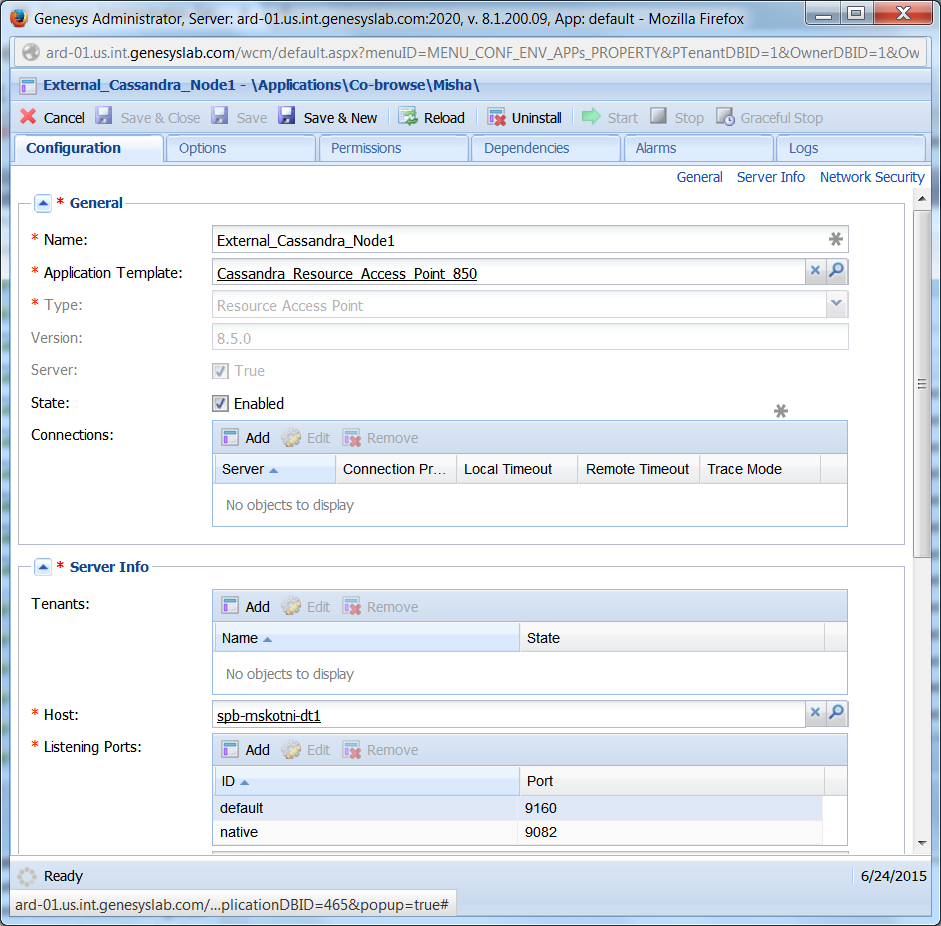What's New in Cassandra Configuration for 8.5.0?
Contents
This page describes changes in Cassandra configuration between Genesys Co-browse 8.5.0 and 8.1.3.
Overview of Changes in Cassandra Access and Management
- Co-browse server can now be interconnected with an external Cassandra cluster.
- Co-browse server now uses a new approach to configuring embedded Cassandra.
- Genesys Co-browse 8.5.0 splits the configuration of the embedded Cassandra node and the Co-browse keyspace.
- Genesys Co-browse configuration is now similar to configuration of GWE and UCS.
- Co-browse 8.5.0 now uses Cassandra 2.X. For supported versions of Cassandra, see Genesys Co-browse in the Supported Operating Environment Reference Guide.
Co-browse Keyspace Configuration
Keyspace specific options are kept in a dedicated configuration section, cassandraKeyspace. These options apply to both embedded and external Cassandra.
Embedded Cassandra Configuration
Co-browse server may act as a Cassandra node. The options to configure the embedded Cassandra service changed in 8.5.0. These options are now in a dedicated section, cassandraEmbedded.
Cassandra Cluster Access Configuration
Embedded Cassandra Access Configuration
When embedded Cassandra is enabled, the Co-browse server will always connect to the embedded Cassandra node when it needs to read or write data in the database. No additional configuration needed.
External Cassandra Access Configuration
In Co-browse 8.5.0, you can use a dedicated Cassandra Resource Access Point in Configuration Server to link a Co-browse server to an external Cassandra cluster.
Procedure: Create a Dedicated Cassandra Resource Access Point
Start of Procedure
- Import the templates Cassandra_Resource_Access_Point_850.apd and Cassandra_Resource_Access_Point_850.xml

- Using the imported application template from the previous step, create one Cassandra Resource Access Point(RAP) for each Cassandra node in an external Cassandra cluster that the Co-browse server needs to communicate with. Configure the following:
- For Host, specify the host of the external Cassandra Node
- Add a default port with the value of the rpc port the Cassandra node is using to listen for Thrift client connections. Optionally, specify rpc protocol for the port.
- Add a native port with the value of the CQL native port the Cassandra node is using to listen for CQL client connections. Optionally, specify native protocol for the port.
-
Configure Cassandra RAP Connections:
- 8.5.000:
- Add Cassandra RAP connections to one or more of the Co-browse Server applications you created.
- Set the enabled option to false in the cassandraEmbedded section of each Co-browse server application in the cluster.
- 8.5.001+:
- Add Cassandra RAP connections to the Co-browse Cluster application object.
- Set the enabled option to false in the cassandraEmbedded section of the Co-browse Cluster application object.

Several connections with different Cassandra RAP applications ensures a redundancy of connections to the external Cassandra cluster. If one Cassandra node in the cluster fails, Co-browse server will be able to cooperate with the external Cassandra cluster through a different Cassandra node. - 8.5.000:
End of Procedure
Configuring a Cassandra Cluster
For more information on configuring a Cassandra Cluster, see Configure a Cluster of Co-browse Servers.

